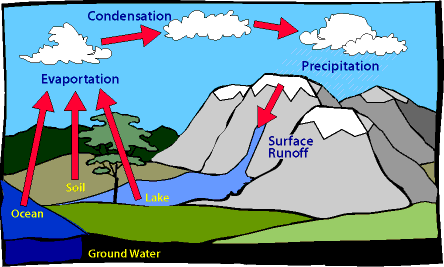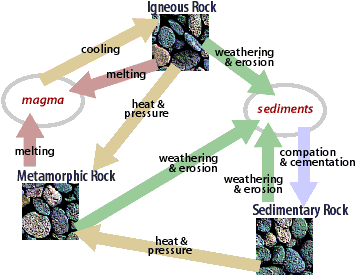
Wetlands:
Overview
Wetlands are just--that wet
lands. They are transition zones between dry lands and waterways. Sometimes
they are referred to as swamps, bogs, fens, bays, or marshes. Wetlands
are found on every continent except Antarctica, and they can be any size--ranging
from a small spot in a field to an area of several hundred square miles.
But what makes a wetland a wetland? Some agencies define wetlands as areas
that have water present at or near the ground's surface for as few as
seven consecutive days. Other agencies state that water must be present
for a longer period of time in order for an area to be classified as wetlands.
Although the exact definition of wetlands may vary, all wetlands share
three characteristics: the ability to hold water (hydrology),
the presence of moist
to wet soil (hydric), and
the presence of water plants (hydrophytes). To
learn more about the definition of a wetland and the various types of
wetlands, visit Athena's
Learning About Wetlands page.
Wetlands form when water collects in a low-lying area where the soil has very poor drainage. The water that fills wetlands comes from many sources. Precipitation is a major source of water for many wetlands. Other wetlands are maintained by water that periodically overflows rivers, lakes, etc. A third source of water for wetlands is groundwater--water that flows underground and sometimes emerges at the surface of the soil. All three of these sources--precipitation, overflow, and groundwater--deliver water to wetlands on regular cycles called hydroperiods, based on the natural cycle of water through the hydrosphere (see below figure).

The water cycle: Liquid water from oceans, lakes, swamps, rivers, and even plants and people evaporates to form gaseous water (water vapor); the water vapor condenses to form clouds, which are millions of tiny drops of water; the clouds lose their water as precipitation (e.g. rain or snow); the precipitation hits the ground and eventually flows to the rivers or enters the ground water system; water in the rivers flows to the ocean while much of the water in the ground is taken up by plants; water evaporates from the rivers, oceans, and plants to the atmosphere, and so the cycle continues.
All types of wetlands--no matter their location--are interesting areas in which the Earth's spheres are closely linked. For example, the activities of some Microorganisms in a wetlands biosphere result in the production of methane that is released into the atmosphere. Meanwhile, certain atmospheric gases such as carbon dioxide may be trapped in the moist soil of a wetlands lithosphere. In addition, many Microorganisms and plants in the biosphere filter toxins and excessive nutrients from the hydrosphere as water flows through the wetlands. This filtering effect is just one of the many important functions of wetlands in nature.
The environmental cycles that occur within each of these spheres are also closely linked. Since all living things require water, the cycle of water through wetlands directly affects the biological cycles of the unique species of Microorganisms, plants, and animals that live there. Cycles of wildfires--which correspond to cycles of wet and dry periods--also impact biological cycles. The rock cycle is yet another process affected by the presence of water (see figure below). Fast-moving water erodes soil and rock, carrying them away toward the ocean, while slow-moving water allows the soil, or sediment, it carries to fall to the bottom of the water channel. This process may eventually result in the formation of sedimentary rock.

The rock cycle: Rocks change form among three types--metamorphic (rock that has been altered by heat and/or pressure), igneous (rock that has formed from cooled melted rock), and sedimentary (rock that is formed by the fusion of pieces of weathered or eroded rock, this may also include pieces of dead organisms.
Throughout history, people have tried to manage wetlands in various ways. Each attempt has had significant impacts on the delicate natural balance of cycles within these ecosystems. Long ago people began draining the water from wetlands and filling them with soil so that the land could be developed for agricultural as well as commercial and residential use. People have also constructed dikes, dams and canals that change the path of water flow in order to supply sufficient amounts of water to agricultural, commercial and residential areas. This change in water flow has caused many wetlands to go dry. Whatever the cause, when wetlands dry up a chain reaction of negative environmental impacts is set into motion. For example, the lack of water in wetlands can result in the disappearance of crayfish. Raccoons and other animals that eat the crayfish would suffer--even starve to death--because of the loss of this food source. Carnivores that may not live in the wetlands, but rely on the raccoons and other wetlands animals as prey, may find themselves looking for new food sources as well. Currently, many groups are restoring and creating wetlands in an effort to correct past mistakes and to take advantage of the beneficial functions of these ecosystems.
For more information on wetlands, visit:
Overview
..|..
Species
..|..
Functions..
..|..
Management
Glossary
..|..
Related
Links
..|..
References
|..PBL
Model
Home ..|.. Teacher Pages ..|.. Modules & Activities
HTML code by Chris
Kreger
Maintained by ETE Team
Last updated
April 28, 2005
Some images © 2004 www.clipart.com
Privacy Statement and Copyright © 1997-2004 by Wheeling Jesuit University/NASA-supported Classroom of the Future. All rights reserved.
Center for Educational Technologies, Circuit Board/Apple graphic logo, and COTF Classroom of the Future logo are registered trademarks of Wheeling Jesuit University.
